Largely forgotten today, USS Timmerman was the last Gearing class destroyer built, being completed to an experimental design years after WWII ended and the rest of the class had entered service.

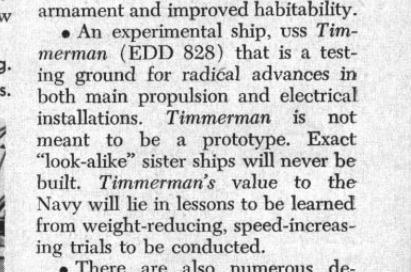
(Clipping from the September 1953 edition of All Hands, the US Navy’s magazine.)
Without question, the Gearing class was the best destroyer of WWII – though it entered combat late in the war and only the first 45 of the class were in service before VJ Day. At the time of Japan’s surrender, it was regarded as not only the best destroyer design anywhere in the world, but by some measure the overall best warship ton-for-ton of any type in any navy. Even today it is regarded as a “legendary” type in naval history, representing the peak of technology in it’s era.
The last true Gearing class destroyer, USS Kepler (DD-765), had her keel laid during WWII but was not commissioned until 23 May 1947. There were also four Carpenter class destroyers ordered as Gearings during WWII but completed as a specialist ASW variant in 1949. By either measurement, there was a 3 – 4½ year lag between USS Timmerman and the rest of the Gearing class.
As designed, the Gearing class displaced 2,616t standard (3,460t full) and measured 390’6″x41’x14’3″. The intended crew was 20 officers and 325 enlisted men. Compared to the regular Allen M Sumner class, the Gearing design was identical but had an extra 14′ section amidships for increased fuel, plus better internal compartmentalization. This lowered the top speed by about 1¾ kts but increased the ship’s range by 25%.

(USS Gurke (DD-783) was a Gearing class destroyer, shown here during WWII.)

(USS Floyd B. Parks (DD-884) was of the later “kamikaze fit” Gearing version, with additional AA guns replacing the aft Mk14 torpedo tubes.)
A total of 98 Gearing class destroyers (originally called “long-hull Sumners”) were built; another 7 were scrapped incomplete after the end of WWII and and another 47 were cancelled before even being started.
USS Timmerman during WWII
There were actually “two” USS Timmermans. The first was DD-816, awarded to Consolidated Steel at Orange, TX in July 1943. Due to labor shortages at this shipyard, work never started and the contract was cancelled, with DD-816 being unused. The name was reallocated to DD-828, a hull ordered from Bath Iron Works in Bath, ME.
USS Timmerman‘s keel was laid on 1 October 1945, about 4 weeks after WWII had already ended. This was in itself somewhat remarkable, as there were already other Gearing class destroyers further along in construction which were scrapped after WWII ended.
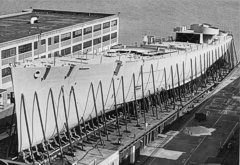
(USS Castle (DD-720) was 60% structurally complete at the end of WWII. The destroyer was never finished and was scrapped incomplete in the 1950s.)
On 7 January 1946, about four months after the end of WWII, the US Navy notified Bath Iron Works to cease work on USS Timmerman. At the time, the basic hull was 45% complete. The shipyard was also instructed not to disassemble the ship, as the hull might be required for a future project. The incomplete destroyer was laid up in a semi-preserved state.
previous similar plans during WWII
During WWII, the US Navy had planned on building two experimental-propulsion destroyers, but both of the Fletcher class. USS Percival (DD-452) was to be a standard Fletcher hull but with the General Electric high-pressure steam system eventually used on USS Timmerman. USS Watson (DD-482) was likewise to be a standard Fletcher hull, but with an experimental diesel-electric lineup of General Motors diesel engines instead of the steam plant. It was forecast that the high-pressure system in USS Percival would give a tremendous increase in speed; while the diesel-electric system in USS Watson would result in a lower speed but much increased range and lower production costs.
Design work on the diesel-based system of USS Watson was never completed and the ship was never even started. Likewise, assembly of USS Percival had not physically begun by the time Japan surrendered. Further work stopped after Japan’s surrender in September 1945 and both destroyers were cancelled on 7 January 1946. Some materials intended for USS Percival were later used aboard USS Timmerman.
USS TIMMERMAN: the ship
engines
The propulsion system was designed by a joint team of Bath Iron Works and Gibbs & Cox. It was essentially two completely different propulsion systems carried inside the same hull. The objective was to determine if the biggest advances could come out of increasing steam pressure on the front end, or increasing shaft revolutions on the rear end, or perhaps both.
The port side was built by General Electric. It had two single-furnace 2,000psi high-pressure boilers followed by a typical Gearing class line-up behind it; a single steam turbine and reduction gearbox attached to a shaft with 4-bladed propeller.

(The high-pressure boiler used on USS Timmerman’s port side was later adapted into a standardized design for use aboard the Mitscher class destroyers, as seen here.) (B.I.W. photo)
The starboard side was built by Westinghouse. It had a pair of 875psi, 1,050°F automated boilers making steam for three (low pressure, cruising, and maximum pressure) steam turbines. All three were linked to a common reduction gearbox that turned a unique high-revolution (1,800rpm) shaft that ran for 72′ down the ship. It terminated at a second reduction gearbox that turned a stub shaft of typical Gearing design, passing through hull packing out to it’s 4-bladed propeller.
Other aspects of the steam lineup were fine-tuned as well. A study was done into boundary layer control (BLC) of the condenser intakes. This refers to hydrodynamic drag in a fluid moving over a solid surface. This was still an infant-stage science in the late 1940s.

A semi-automated control panel ensured that the port and starboard propellers were turned at a common speed irregardless of the differences upstream in each one’s lineup. A new lightweight steering system was installed on both rudders, replacing the heavy hydraulic rams of WWII-built Gearings.
By early 1950s standards, this was a tremendously complicated set-up and even now in the late 2010s would be of above-average complexity. USS Timmerman‘s combined engine room weighed 104 tons less than a WWII-built Gearing‘s but output 100,000hp compared to 60,000hp in the normal design.
electrical
One of the US Navy’s primary objectives was to investigate the feasibility of high-voltage alternating current aboard warships. During WWII, an increasing number of systems used 400Hz alternating current, which differed from the main 60Hz lineup. Each of these items required it’s own oscillator in addition to any transformers needed to change the actual voltage. Late in WWII, it was reasoned that maybe at some point, it would make more sense to just change the whole ship’s lineup to 400Hz.
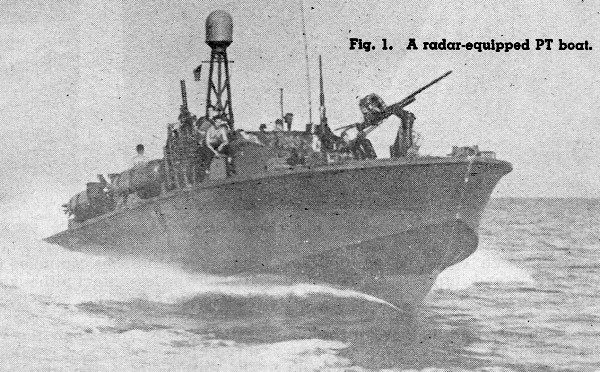
(The type SU radar was a WWII system that used 400Hz electricity.)
USS Timmerman‘s electrical system was 400Hz 1,000vAC, compared to the normal 60Hz 450vAC. A new lightweight design of generators was installed, producing 650KW. The destroyer’s wiring used new insulation materials which reduced their weight by 55% compared to WWII systems.
Because no naval base (and pretty much, nowhere in the USA overall) used this voltage, USS Timmerman had a special conversion generator installed on the 01 level ahead of the forward smokestack. It accepted a 60Hz 450vAC input from ashore and produced 400Hz 1,000vAC for use aboard, so that the destroyer would have electricity pierside.
gas turbine
USS Timmerman carried one Solar 500hp Jupiter gas turbine. Gas turbines were still a very new technology at the time, even slightly newer than jet engines on aircraft.

During WWII, BMW proposed their GT 101 gas turbine as a powerplant for the PzKw V Panther tank. In 1947, the Royal Navy experimentally fitted gas turbines in two small gunboats left over from WWII. The US Navy had installed small gas turbines aboard a mine boat MSB-28 for quiet electricity generation, and a 40′ test boat Solar Meteor as it’s sole propulsion. USS Timmerman was the first installation aboard a large seagoing warship.

The Bath Iron Works / Gibbs & Cox team which designed USS Timmerman‘s engine room layout originally wanted to have one half powered by gas turbines. It was decided that the technology was not mature enough yet for that big of a task so the lone turbine was relegated to a secondary role. The Jupiter aboard USS Timmerman was not linked to the propulsion system but rather powered an emergency electrical generator.
structural
Lightening future destroyer classes was another objective of the USS Timmerman project. During WWII the US Navy saw worrisome growth in the topweight of warships from the addition of new radars, anti-aircraft guns, radios, and fire control directors never envisioned when the hulls were designed. Most of this gear was carried above the ship’s centre-of-gravity, and in the case of radar dishes and radio antennas, far above it. Each new thing added to a class’s design also added “hidden weight”; for example the copious number of 20mm AA guns added to fight the kamikaze threat had not only the weight of the gun, but also it’s mount, the crewmen, and the huge amount of ammunition each consumed. Likewise a new radar added not only the weight of it’s visible antenna, but also the mast it sat on, it’s waveguide, electric cabling, and processors.

(As an example, here is the 1930s-vintage Porter class destroyer USS McDougal (DD-358) before WWII, showing the original layout.)

(This photo shows USS McDougal during WWII. The circles were added by Charleston Navy Yard and show new AA guns, radio antennas, fire control gear, heavier mast, Type SC-1 air search radar, Mk4 gunnery radar, and the enlarged bridge – all new topweight added during WWII.)
By the end of WWII in September 1945, the issue was critical. In the autumn and winter of 1945, the US Navy experimented with several ideas to reduce weight above centre-of-gravity on wartime-built vessels. The easiest solution was just to remove low-caliber (.50cal and 20mm) AA guns, which was done to an extent. Other ideas tried included using lightweight alloy (or even open grates) for internal walkway planking, and the use of aluminum for some topside features. None the less, by the end of the 1940s discoveries in military electronics continued at a rapid pace, and the US Navy expected that both the quantity and size of radar dishes and automated weapons mounts would only keep increasing for the foreseeable future.
Aboard USS Timmerman, various types of lightweight steel alloy were used in sections of hull plating and in the interior. One of the 5″ turret’s rotation bases was an experimental aluminum design. USS Timmerman‘s forward superstructure was of generally similar shape to a normal Gearing‘s, but made entirely of aluminum. It was a solid structure, but was of mixed construction, one half being electrowelded and the other riveted, to see which performed better. There were no expansion joints in the forward superstructure, with the elasticity of the aluminum itself intended to compensate.

(USS Timmerman’s aluminum superstructure was installed as one module on 16 November 1950, in a daring three-crane lift which sat it precisely on the steel hull.) (photo from book Bath Iron Works by Andrew Toppan)

(Overhead view of USS Timmerman’s aluminum superstructure in September 1952.)
The actual hull of USS Timmerman differed from the rest of the WWII Gearing class. The height from the keel of USS Timmerman to the peak of the bow was 2′ taller, to cope with the ship’s expected higher speeds. The heightened bow was faired into the existing Gearing hull design, which required moving the forward 5″ turret back seven feet. It also disturbed the normal anchor chain handling layout. USS Timmerman was completed with two lightweight danforth anchors, recessed into the hull sides, instead of the Gearing class’s normal 4,000 lbs stockless bower design of WWII.

(The heightened forward bow of USS Timmerman, also showing the recessed lightweight danforth-style anchor.)

(For comparison, a normal Gearing class anchor.) (photo via navsource website)
weapons and sensors
One aspect the US Navy did not intend to use USS Timmerman for was new combat systems. Moreover it was expected that the experimental ship would never see combat. As such, the destroyer was completed with more or less a standard Gearing class fit, less some changes due to the passage of time since the rest of the class had been built.
The main guns were three twin Mk32 5″ guns, the same as any other Gearing class. This was unquestionably the best 5″ gun of WWII, highly effective in both the surface combat and AA roles. The primary AA weapons were Mk2 (twin) / Mk4 (quad) 40mm guns. Compared to a normal Gearing, USS Timmerman had one less Mk4 installation as a second smallboat replaced a mount on the starboard side.

(Mk4 quad 40mm AA gun)
By the end of WWII, Gearing class destroyers with the “kamikaze fit” carried eight Mk20 (twin) and two Mk16 (single) 20mm light AA guns. These had a range of about 4,000 yards and could fire up to 10,000′ altitude. Because of a desire to keep the aft deck clear and other layout tweaks, USS Timmerman carried only five Mk20 20mm guns. It’s fairly surprising that USS Timmerman had any 20mm guns installed at all. These manually-aimed weapons were very effective against kamikazes in the last eleven months of WWII, but by the end of the 1940s, it was realized they would be ineffective against jets in any upcoming war. New warships were often designed without them, and the US Navy was already removing them off some WWII-veteran ships. The reason that they were included on USS Timmerman has been lost to time. USS Timmerman was the final American destroyer commissioned with 20mm AA guns at construction, until the Mk15 Phalanx CIWS gatling system entered service in the early 1980s.

(Mk20 Mod2 twin 20mm AA gun.)

(WWII-vintage 40mm (in tubs) and 20mm (on the stack platform) AA guns aboard USS Timmerman, along with their off-mount Mk29 directors in the small ‘cups’. The asymmetric layout was not unusual, and intended to pack the maximum number of guns aboard while giving each a reasonable firing arc. This also shows USS Timmerman’s extra smallboat on the starboard side.)
During WWII, Gearing class destroyers carried two Mk9 depth charge racks and a half-dozen Mk6 K-gun projectors. USS Timmerman was completed with a fully functional sonar system but never received any of these anti-submarine warfare weapons. Just like the 20mm guns, the reason why has been lost to time.
The Gearing class during WWII had two Mk14 quintuple 21″ tubes for unguided Mk15 ship-to-ship torpedoes. The “kamikaze package” already deleted the aft torpedo mount to make room for more AA guns. By the time USS Timmerman commissioned, the US Navy was already abandoning surface-duel torpedo tactics so there was no sense in installing the forward mount inbetween the smokestacks. Instead this place was used for research equipment.

(Close-up of USS Timmerman’s amidships area, showing some of the 20mm and 40mm AA guns, the aluminum superstructure, the research compartment added where the amidships torpedo tube bank went on normal Gearings, and the two DBM radomes on the aft smokestack.)
For the main 5″ gun battery, USS Timmerman carried a pre-production model of the Mk67 fire control system. This replaced the WWII-era Mk37 normally found on the Gearing class. It did away with the latter’s 1½” armor and was much lighter. The Mk67 had a stereoscopic optical rangefinder and was topped with a Mk25 X-band gunnery radar.

(USS Timmerman’s gunfire director.)
Inbetween the time USS Timmerman commissioned and the rest of the Gearing class had been built, the WWII-era SA air-search radar had gone out of production, so instead USS Timmerman was completed with a Cold War-era AN/SPS-6 system, The surface search radar was a SG-6, a postwar modification of a WWII system. USS Timmerman was fitted with the WWII-vintage DBM radar intercept gear on the aft smokestack, but had any jamming gear omitted to save money.

(USS Timmerman’s lightweight foremast in July 1952, showing the large AN/SPS-6 and smaller SG-6 antennas.)

(Components of the SG-6 radar.)
miscellaneous
As USS Timmerman was never intended for long deployments, the Gearing class’s extra amidships 14′ fuel tank was instead used as a scientific research space. This was not altogether successful as this area of the ship, not designed for habitation, experienced significant vibration which damaged the electronics.
USS Timmerman tested the US Navy’s first modular chillwater plant for the galley’s refrigerator. The goal was to develop a fleetwide model that could be built anywhere in the country, shipped to any shipyard, and installed on any future warship class.
THE PROGRAM
On 24 May 1946, the US Navy officially began the USS Timmerman project. Work at Bath Iron Works on the dormant WWII hull restarted in June 1946. The US Navy’s Bureau Of Ships gave wide latitude to the shipyard, telling them to use their imagination. The government agreed to cover any cost overruns (other than gross construction negligence) to coax the designers into taking chances with the design. Perhaps for the only time in it’s history, the US Navy stated “…the ship is not intended to be completely reliable”.

(The new heightened and enlarged bow being completed in February 1949.)

(USS Timmerman under construction in January 1950.)
USS Timmerman was not a high-priority item in the late 1940s US Navy, which was in the midst of severe budget cuts following the end of WWII. Not surprisingly, the highly-experimental ideas being put into the design resulted in many delays, and it took half a decade to get the hull in a condition ready for launch. The protracted timeline resulted in personnel (both naval and shipyard) being reassigned or retiring, requiring replacements to be brought up to speed.
By early 1951, with the Korean War now underway, the US Navy wanted to see some result out of the project and instructed Bath Iron Works to just hurry up and finish the destroyer. On 19 May 1951, USS Timmerman was finally launched.

(Launching of USS Timmerman.)

(USS Timmerman, riding high in the water without the guns and radars installed, being moved after launching.)
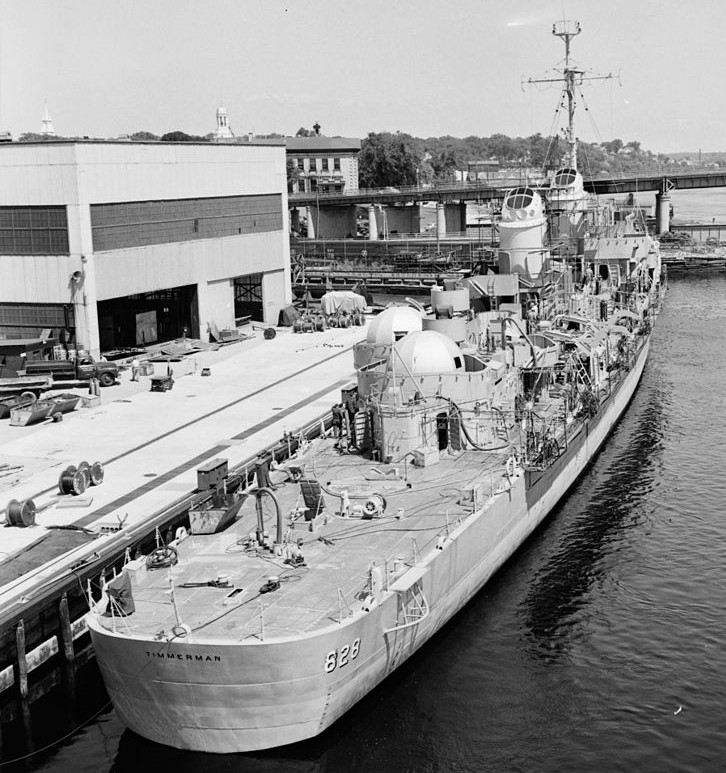
(USS Timmerman fitting out at Bath Iron Works in 1951. The “igloos” over the AA guns were left over from the post-WWII warship mothballing process and protected the weapons from the weather during the destroyer’s protracted fitting out.)
The fitting-out period took another 1½ years and the ship finally commissioned on 26 September 1952. The hull number was changed to EDD-828, for “experimental destroyer”.

(Commissioning ceremony of USS Timmerman.)

(It was obviously impossible to make an entire commissioned destroyer “secret”, but aspects of USS Timmerman’s design were confidential at the time. For the ship’s 1st Day postal cover, a generic warship sketch was used instead of the actual vessel.)

(A fairly remarkable photo, this shows USS Timmerman alongside USS Mitscher (DL-2) under construction. The two destroyers commissioned the same year but the “newborn fossil” Gearing class ship was much smaller than the Cold War vessel.)
USS Timmerman was assigned to the 1st Naval District’s Operational Development Force, and nominally homeported in Boston, MA; however due to the constant care needed for the finicky systems aboard, the destroyer spent significant time back at Bath Iron Works in Maine.

(USS Timmerman pierside at Bath Iron Works in January 1952. This shows the “clean” aft deck, with the depth charge racks and light AA guns normally found on a Gearing class missing.)

(USS Timmerman running tests in April 1953.)
USS Timmerman ran constant tests on the experimental systems aboard from late 1952 through mid-1956. In January 1954 the hull number was changed from EDD-828 to AG-152 (in the “miscellaneous auxiliary” lineage) reflecting that the ship had no real combat role. While normally confined to the USA’s eastern seaboard, USS Timmerman made one brief cruise abroad, visiting Havana, Cuba in 1956.

(USS Timmerman in 1952. In the background under construction is USS Terrebonne Parish (LST-1156), leadship of a Cold War-era class intended to replace the ageing amphibious ships of WWII.)
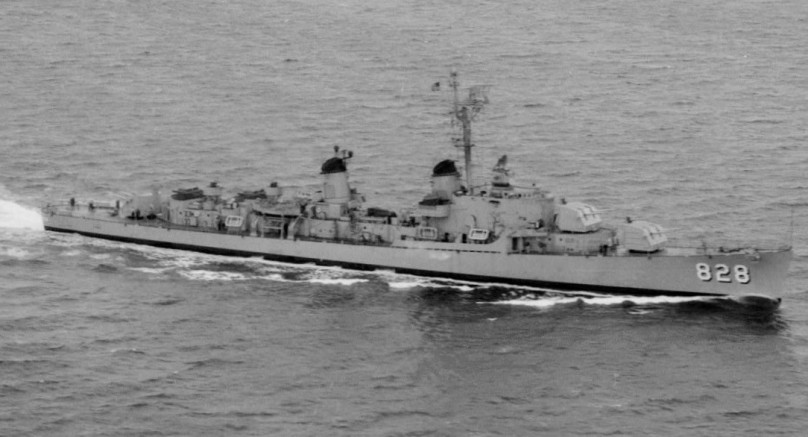
(USS Timmerman in September 1952.)

(USS Timmerman visiting Newport, RI in July 1953.)

(This was an interesting experiment USS Timmerman performed. The US Navy was researching if vibrations on real warships could be accurately studied on scale models.)

(USS Timmerman in the mid-1950s.)
On 27 July 1956, USS Timmerman was decommissioned. The ship was still used for some pierside experiments thereafter, and eventually had the 5″ turrets removed and replaced by concrete ballast. In September 1956, the ship was towed from Boston, MA to the Naval Inactive Ships Maintenance Facility mothball piers at Philadelphia, PA. When the 1958 naval budget was being written, the US Navy notified Congress that it would have no further need for the hull and on 4 April 1958, the ex-USS Timmerman was stricken from the reserve rolls. In 1959, the hull was towed to Maryland and scrapped.
RESULTS
electrical
USS Timmerman‘s 400Hz 1,000vAC system did not yield the desired results. From a military perspective, it saved weight and could run an enlarged array of electrical loads. However the high-cycle motors and servos were more expensive to begin with, broke down more frequently, and wore out much faster, than normal 60Hz gear. The high-cycle, high-voltage layout overall was unreliable and USS Timmerman suffered partial or full electrical failures regularly. At one point nearly every underway was ending in an electrical failure of some sort.

(A purplish corona discharge around a resistor on a high-voltage electrical line.)
An unexpected problem of the much-increased voltage was corona discharges aboard USS Timmerman; this is when an electric current ionizes air around a charged conductor, causing a power drop in the circuit. It also produces a characteristic glow and foul smell.
The electrical aspect of the tests was judged an abject failure.
gas turbine
The gas turbine installation was an overwhelming success. The gas turbine aboard USS Timmerman powered an emergency electrical generator, which automatically started when both the destroyer’s primary and secondary electrical plants went offline. The kit’s output was 250kW and start-up was nearly instantaneous, with a full load being available in 30 seconds or less.
Gas turbines clearly pointed to the future, not just for electrical generators but as the ship’s complete propulsion, and many of the US Navy’s late Cold War-era warships, including the Spruance, Kidd, and Arleigh Burke destroyer classes. O.H. Perry class frigates, and Ticonderoga class cruisers; all utilized this propulsion method.
high-pressure steam propulsion
This was a mixed bag. The General Electric (2,000psi) side of the engine room generally performed better than the Westinghouse side; which was constantly hampered by failures in it’s “second” reduction gear, which was of a strange planetary design.

(USS Timmerman at high speed.)
When everything was working, the experimental high-pressure steam systems output tremendous power. During builder’s sea trials in 1952, USS Timmerman was officially rated at 41½ kts, while the crew felt that the ship had briefly been at 43 kts. Either way, this was by far the fastest American destroyer after WWII. Once commissioned, the ship never again ran that fast, as the US Navy was hesitant to stress the experimental steam plants too much. Rarely did USS Timmerman exceed 25 kts the rest of her career.
The work done aboard USS Timmerman paved the way for a big one-step increase in the standard operating steam pressure of US Navy surface warships. For comparison, the Bainbridge class destroyers (1908) had 250psi, the Porter class destroyers (1936) had 300psi, and the Allen M. Sumner class (1944) had 565psi. However after USS Timmerman, many ships starting with USS Mitscher (DL-2) in 1953 moved way up to 1,200psi boilers. This became the standard operating pressure for several decades; some ships using it were the Garcia and Knox class frigates, the Forrestal class aircraft carriers, and a whole variety of missile cruiser classes. The research done aboard USS Timmerman was also important to the nuclear navy, which used high-pressure steam in the post-reactor portion of their engine rooms.
Quite ironically, this innovation had negative consequences for the US Navy many decades later. During the mid-1990s, the administration of President Clinton identified the US Navy’s high-pressure 1,200psi steam systems as an item that would generate manpower, training, and spare parts savings if eliminated. This led to the flushing out of remaining Knox class frigates, and more importantly the unfortunate “1990s Cruiser Slaughter” which saw the premature decommissioning of the Leahy, Bainbridge, Belknap, California, Truxtun, and Virginia class cruisers. The atomic-powered Virginia class was an especially bitter loss, as they were fine ships with many years of life still in them.
structural
The results of the aluminum superstructure were likewise mixed. It did not present any problems in service, but the US Navy was concerned about how it would perform in a fire.
In future Cold War destroyer classes, the WWII problem of topweight growth was simply solved by building much bigger hulls.

(USS Timmerman alongside the incomplete USS Mitscher at Bath Iron Work’s North Pier. The Cold War-era ship was 100′ longer and 50% heavier than the WWII destroyer.)
The “modular” construction and installation technique of USS Timmerman‘s aluminum superstructure was a success. Later destroyer and frigate designs used this, culminating in the Spruance and Kidd classes, in which entire sections of the ship were built as modules.
POSTSCRIPT
In the broad history of the Gearing class, USS Timmerman is barely a footnote, but during the ship’s brief career, it pointed the way to many technologies of the future.


Reblogged this on Brittius.
LikeLike
Fascinating information. Thank you!
LikeLiked by 1 person
I thoroughly enjoyed this article. I would like to share this if allowed.
LikeLike
yes no problem
LikeLike
By share, I do not mean social media. I run a history website on naval topics where several authors share their work. I would like to share your article as we have had several questions about Timmerman. Of course, we would also link back to your site.
If you would like to discuss this in depth, we can continue in email.
LikeLike
yes it’s no problem
LikeLike
Thank you very much. I linked back to your website from ours. https://www.navygeneralboard.com/the-experimental-uss-timmerman/
LikeLiked by 1 person
I served on this ship when it was commissioned in Bath, Maine
LikeLike
My Father was on this ship.
LikeLiked by 1 person
would love to talk with you. My father was Howard C Dean and served aboard the 828 from 1950 – 1954
LikeLike
would love to talk with you. My father was Howard C Dean and served aboard the 828 from 1950 – 1954
LikeLike
Lightest and fasted DD in service at this time
LikeLike
Extremely interesting and thoroughly researched. Experimental ships like this one are always intriguing – I wonder what the swabbies made of them? (Your presentation, otherwise quite professional, would be improved by learning the difference between the words ‘its’ and ‘it’s’ – they aren’t interchangeable. You wouldn’t call starboard larboard, would you?)
LikeLike
Reblogged this on battleoftheatlantic19391945 and commented:
WARSHIP WEDNESDAY, APRIL 21, 2021@22:42-U.S.S. TIMMERMAN DD-828, IS ONE OF YOUR WARSHIP WEDNESDAY BLOG’S, AND BY THE WAY; IF YOU ARE A MILITARY NUT, AS SOME OF MY AMERICAN BUDDIES ON YAHOO MILITARY QUESTIONS AND ANSWERS, Y’ALL HAVE TO CHECK OUT W.W.II AFTER W.W.II=WOW, TALK ABOUT MILITARY HISTORY, WITH A GREAT BIG BRAVO ZULU!!!
Note: JUST JOKING; A BUCH OF GOOD AMERICAN GUYS/MEN ON YAHOO MILITARY QUESTIONS AND ANSWERS, AND THEY KNOW VERY MUCH, ABOUT THE MILITARY, EXCEPT THE CANADIAN COWARD DETECTIVE-Gary OSTOFI!!!
CREDIT: W.W.II after W.W.II, BLOG!!!
Brian Murza…Killick Vison, W.W.II Naval Researcher-Published Author, Niagara Falls, Ontario, Canada.
LikeLike